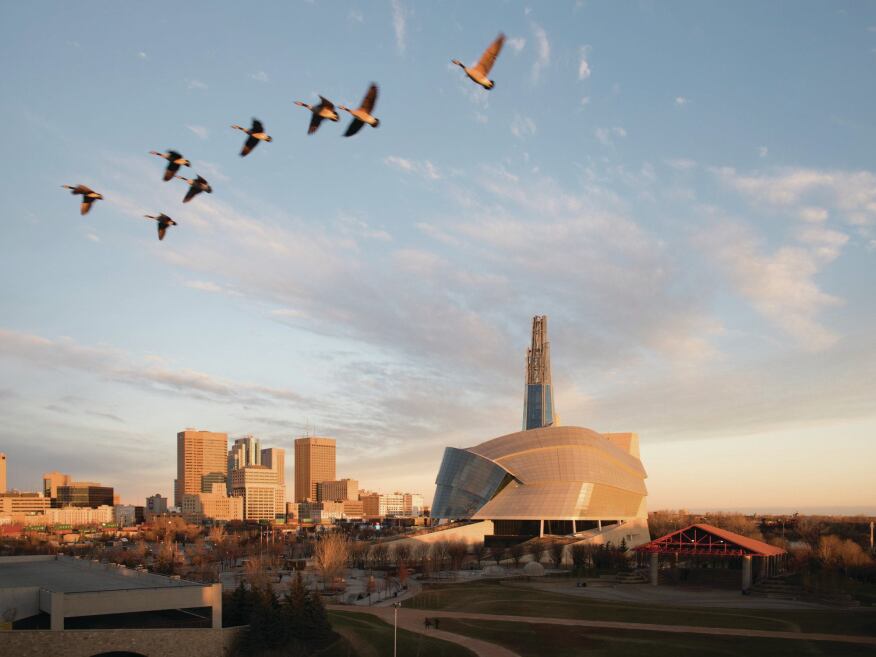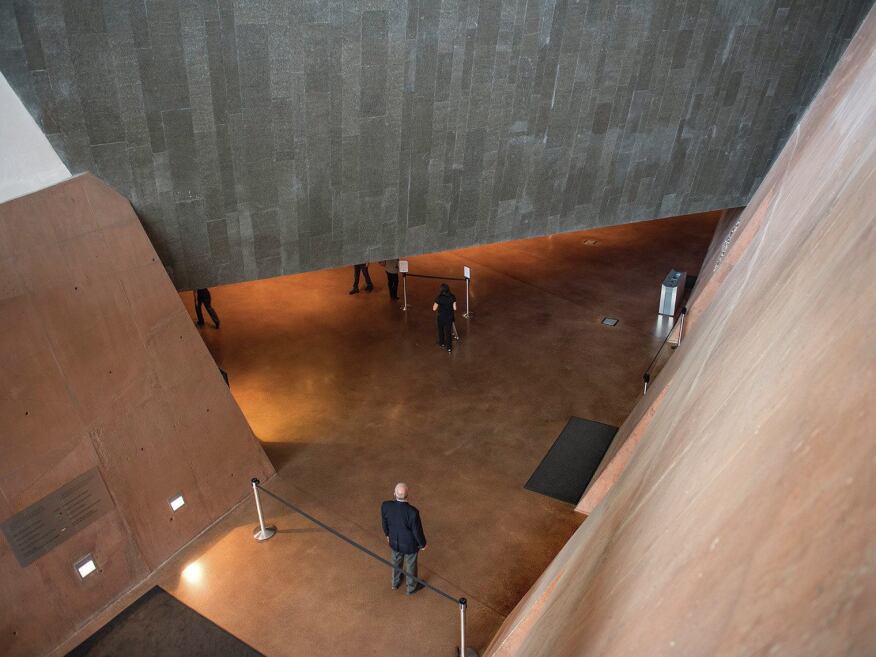
“Aw, that was just showing off,” says Antoine Predock, FAIA. He’s talking about a stunt, made famous in a 1986 photograph he’s sometimes used as a lecture slide, in which he slalomed down the snow-covered roof of a building he designed in Taos, N.M.—not far from Albuquerque, where his practice has been based for some 50 years. “I’m a skier,” he explains, “and I spent a lot of decades of my life going off the marked trails.” The photograph captures a paradox in Predock’s work: On the one hand, the enthusiasm of this lifelong skier—and motorcyclist, and diver—for the kinetic, for technologically enhanced speed, and for perception in motion; and on the other hand, a deep feeling for geology, for the stillness of mountains and deserts. Most notably, perhaps, there’s an enthusiasm for architecture that—with stony materiality and eremic geometry—registers as landscape. (Or at least as something that it would be great to ski on, weather permitting.) That off-piste trajectory also reflects the singularly trailblazing-but-backcountry path of this regionally rooted architect who—despite a 1960s stint in New York and studies at Columbia University (not to mention a 1985 Rome Prize, a 2006 AIA Gold Medal, and a 2007 Smithsonian Cooper Hewitt lifetime achievement award)—has largely escaped the categorizations and approbations found on the coasts.

And, these days, it matters that Predock knows his way around snow. His landmark new project in Winnipeg, Manitoba, the Canadian Museum for Human Rights, opened in September 2014, and is weathering its first sub-zero winter five years after the start of construction and nine years after Predock’s selection in an international design competition. The 260,000-square-foot structure features 47,000 square feet of galleries within a cliff-like tower clad in local Tyndall limestone, alongside a 7,000-square-foot atrium winter garden partway up the structure, enclosed by a south-facing swoop of some 5,000 uniquely shaped glass panels. The whole is topped by a 100-meter-tall crystalline tower out of the dreams of Bruno Taut. And framing the entrance are four massive berms, three planted with prairie sweetgrass, one stepped into an amphitheater.

The museum’s development faced hurdles: a Great Recession budget grown far past early projections to a reported $351 million Canadian; wrangling between its private foundations and public administrations; curatorial controversies about the museum’s treatment of everything from the history of Canada’s First Nations indigenous peoples (its site at the confluence of Winnipeg’s Assiniboine and Red Rivers was an aboriginal trading and meeting place), to the relative status and scale of exhibits like those on the Armenian Genocide and the Ukranian Holomodor. Predock, designing his most substantial North American project outside of the Southwest, faced an icy reception from some. “At first,” he says, “it was: ‘What, you chose a guy from New Mexico?’ ” But, characteristically, he frames that as a matter of geology and ecology: “It’s cold as hell here right now,” he says of Albuquerque in January. “It’s a high desert, the altiplano, and the land loses heat to the universe. When you make an event on that tall grass prairie [in Manitoba],” he says, “it’s like a mountain down here in the desert.”

There must still have been something of the so-called Bilbao Effect in the cold Manitoba air back in 2000, when the late Israel Asper, a Winnipeg-based Canadian media magnate, proposed and seeded the museum with a $22 million Canadian gift from his family foundation: The notion that a scrappy city on the global margin could—like Bilbao, Spain, with its photogenic branch of the Guggenheim designed by Frank Gehry, FAIA—seemingly acquire cultural capital with an architectural showstopper. Maybe even a memory of Jørn Utzon’s Sydney Opera House, from a generation earlier. And, certainly, the Museum of Human Rights’ uncanny form is a big deal on Winnipeg’s boxy skyline and prairie horizon.

But in Winnipeg, the result is more interesting. Unlike that Spanish museum (whose overexposed sheen faded as its interiors underperformed for the display of art), the Museum of Human Rights appears to have been designed from the inside-out—driven less by photogenic form than by a cinematically and psychologically immersive experience over time. “It isn’t a museum of objects,” Predock says. “It’s a museum about ideas. It’s a process building. It’s a procession building.”

The procession is choreographed and kinetic. Recalling the switchback canyon roads where he rides his motorcycles, Predock describes the path through the museum as a “back and forth duality of light and of dark. It’s a big-picture duality, dark where you begin, light where you ascend.” At the entrance, “you’re in a chamber with fissures of light coming in under dark above,” he says. Then “you ascend, like in a John Cage concert when he would just sit at the piano and not play.” The ascent leads, “to a narrow space that starts out as a black void. It’s lined in integrally colored black concrete, not paint or plaster,” and spanned by ramped bridges clad in luminous alabaster. A full kilometer of shallow switchback ramps criss-cross that void, leading in and out of all the galleries (“black-box theaters,” Predock calls them, with interactive screens and supergraphics by exhibition designer Ralph Applebaum). “It’s episodic,” Predock says. “Along the way, the bridges are way stations. When you get onto them, one after the next, you are in this safe zone, and you can look up at the sky and down to the earth. You think about what you’ve seen and get ready for the next gallery. There’s a lot of bad stuff you learn about. But a lot of good stuff too. You look up and you think: ‘Oh man, I’ve got a long way to go,’ and ‘I wonder if I’ll make it to that tower.’ ”

Gratifyingly, you can, and into a panoramic lookout by way of more ramps and a spiral staircase overlooking the atrium winter garden, which is paved by hexagons of Mongolian basalt buttressing reflection pools. The garden is also overlooked by foundation and administration offices, left open to view, “making what’s normally the backstage totally visible,” Predock says. “You see people hustling, working on human rights issues in real time. It’s light and bright and the white steel all around is buoyant, and there’s this animation that you’re picking up on. It’s about action.”

This building is itself, perhaps, more about action than seamless completion—more open to personal experience and individual interpretation than the totalizingly hermetic self-reference to which many contemporary would-be monuments are prone. There is something of the deliberate awkwardness of a modern dancer who eschews the pretty gesture in order to tell you something else: Here, the seams show—massive nodes of raw structural steel push past the stone and glass to let you know that for all its volcanic and glacial geomancy, the building is the work of human industry and intention.

Like the high aspirations and human failings illustrated by the exhibitions, this building’s finishes are a little rough and its transitions a little syncopated: An incongruous glimpse of alabaster is visible from the basalt interior landscape; light seeps into darkness and darkness into light. The design for the Sydney Opera House by Utzon—to whose work Predock’s is heir in its primal encounters between land and sky—was said to have been rescued from the reject pile by Eero Saarinen, whose work shares with Predock’s its uncategorizable mutability and its expressive sensibility. Utzon and Saarinen, and now perhaps Predock, have long served as an irritating conscience to an architectural profession that has, steadily and calculatedly, settled for less and less in the aspirational mission of the built environment. Something about Predock’s Canadian Museum for Human Rights serves as a reminder that, even as you seek to live out humane values far from the follies and fortunes that architecture requires, sometimes—however secularly, however awkwardly, however ambitiously—you also need a cathedral.













Drawings




Project Credits
Project: Canadian Museum for Human Rights, Winnipeg, Manitoba
Client: Canadian Museum for Human Rights
Design Architect: Antoine Predock Architect, Albuquerque, N.M. . Antoine Predock, FAIA, Jose Sanchez, AIA, Graham Hogan, AIA, Paul Fehlau, Karole Mazeika (project team)
Executive Architect: Architecture49 (formerly Smith Carter Architects & Engineers) . Jim Weselake, Scott Stirton, Grant Van Iderstine, Ron Martin (project team)
General Contractor: PCL Constructors Canada
Structural Consultants: Yolles, A CH2M Hill Co.; Crosier Kilgour & Associates
Mechanical Consultant: SMS Engineering; The Mitchell Partnership
Electrical Consultants: Mulvey & Banani International; MCW/AGE Power Consultants
Geotechnical Engineer: KGS Group
Interior Design: Antoine Predock Architect; Architecture49 (formerly Smith Carter Architects & Engineers)
Landscape Architect: Scatliff+Miller+Murray
Exhibit Design: Ralph Applebaum Associates
Museum Planning: Lord Cultural Resources
Size: 24,155 square meters (260,002 square feet)
Cost: $351 million Canadian ($296.9 million U.S.)
















